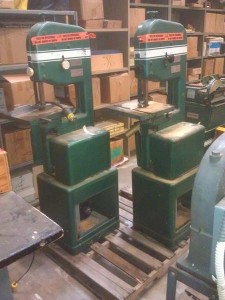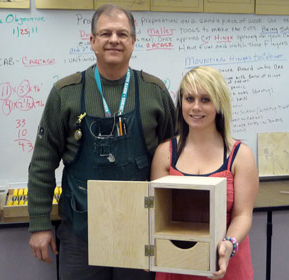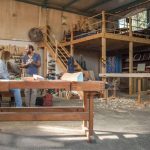We may receive a commission when you use our affiliate links. However, this does not impact our recommendations.
 These days when you read about high school wood shops, it’s almost always in the context of a program shutting down, the equipment auctioned off and resources diverted to sending every kid that graduates high school to college. That makes sense if you think we don’t need to make anything domestically and that blue collar jobs are dead-end jobs. In spite of this, there is a high school wood working program at North Salem High School in Salem, Oregon that has students lining up to get in. And when they graduate, employers are lining up to give them jobs.
These days when you read about high school wood shops, it’s almost always in the context of a program shutting down, the equipment auctioned off and resources diverted to sending every kid that graduates high school to college. That makes sense if you think we don’t need to make anything domestically and that blue collar jobs are dead-end jobs. In spite of this, there is a high school wood working program at North Salem High School in Salem, Oregon that has students lining up to get in. And when they graduate, employers are lining up to give them jobs.
The main reason for that success is the instructor, Dean Mattson who was named 2013 Wooden Globe Educator of the year by the Woodworking Machinery Industry Association. Mattson had experience in the cabinet industry and when he began teaching, he looked to industry for guidance. What he found surprised him. It surprised me as well and it probably will surprise you.
In a country with an unemployment rate that fluctuates between 7% and 10% and few job opportunities available for new high school graduates, the woodworking industry has around 20,000 unfilled jobs due to a lack of qualified candidates. Mattson figured out how to connect the dots by challenging his students and the local industry to work together. He began to gear his curriculum so that his students could fill those positions and challenged local shops to give them jobs.
In his recent keynote speech at the 2014 Woodworking Industry Conference he said:
“We re-evaluated the leadership and the product we are producing, determined why our product is in demand and how we could keep it in demand.
- We re-established in our minds that the products we produce are young people who understand they are valued by society.
- We determined the reason our product is in demand is because we are producing high school students who are taught the necessary principles of life. They are schooled in the process of hands on application of Lean Manufacturing. They are placed in real life manufacturing scenarios where they are forced to think critically. And we try to model for them how to be gracious human beings. They are ready for the job market with an annual compensation package of $50,000.00. Or, they are ready for the university.”
 Making the connection wasn’t a simple task. North Salem High School is considered a “Title One” school with a large portion of students below the poverty line. In addition, there are a significant number of students who are homeless. Obviously, there is a lot more than woodworking involved in getting these kids from point A to point B. One of the big motivators was the promise of a decent job after graduation.
Making the connection wasn’t a simple task. North Salem High School is considered a “Title One” school with a large portion of students below the poverty line. In addition, there are a significant number of students who are homeless. Obviously, there is a lot more than woodworking involved in getting these kids from point A to point B. One of the big motivators was the promise of a decent job after graduation.
Dean Mattson has also challenged the industry and educational system as a whole to support his and similar efforts. Secondary school and college woodworking programs are looking at his experience and methods to create similar successful programs. Manufacturers of wood products and woodworking machinery are seeing the value of skilled and motivated employees. In his speech he outlined his vision for a model training center.
You can read the entire text of Dean Mattson’s keynote address here.
– Robert W. Lang
You can read more about Dean Mattson on my personal blog.
Here are some supplies and tools we find essential in our everyday work around the shop. We may receive a commission from sales referred by our links; however, we have carefully selected these products for their usefulness and quality.









A little late to this entry, but can anyone tell me what types of jobs the “woodworking industry” encompasses, when it says there are over 20,000 unfilled jobs available? Would that be mostly cabinetry companies? Does it include finish/trim carpentry? Lumber, mills? Just curious, as it’s a broad term.
Thanks.
This dovetails nicely with the work that Mike Rowe (formerly of “Dirty Jobs”) is doing to support education and job placement in the skilled trades, via the “Mike Rowe Works Foundation.” http:\\MikeRoweWorks.org.
What options we present to students, what paths we suggest to young people, these are important topics. There are no simple answers, but I appreciate that this on blog, people are able to talk about things without getting stupid. Thanks to my woodworking brothers and sisters. Normally I wouldn’t be reading the blog so much but I have 30 days to go in Afghanistan and my woodshop is calling me! BTW, I had to take calculus instead of woodshop because I tested “too smart.” It’s thirty-something years later and I am not even sure I spelled calculus correctly.
Cool read, we need to get this Mattson guy cloned. Teaching IA should hardly stop at showing a bunch of kids how to…………………….
When I went to HS there was a teacher for woodworking, if you took that, you learned how to make a checkerboard in your Junior year, and woohooo object of your choice Senior year, as long as it wasn;t too ambitious (COST). After graduation you were pretty much clueless, and on your own to find work. Same school, had a Machine shop teacher that had you grind, drill, proportion all kinds of shapes, looked boring as all get out, after school all of the kids in Machine shop got placed in Machine shops working full time. This was 1972. It’s all about the teacher, and Tenure is a really bad word, in most cases.
Amazing timing! This dovetails (ahem) perfectly with what I’m doing on my blog, except that instead of high school students I’m focusing on veterans, another group facing high unemployment.